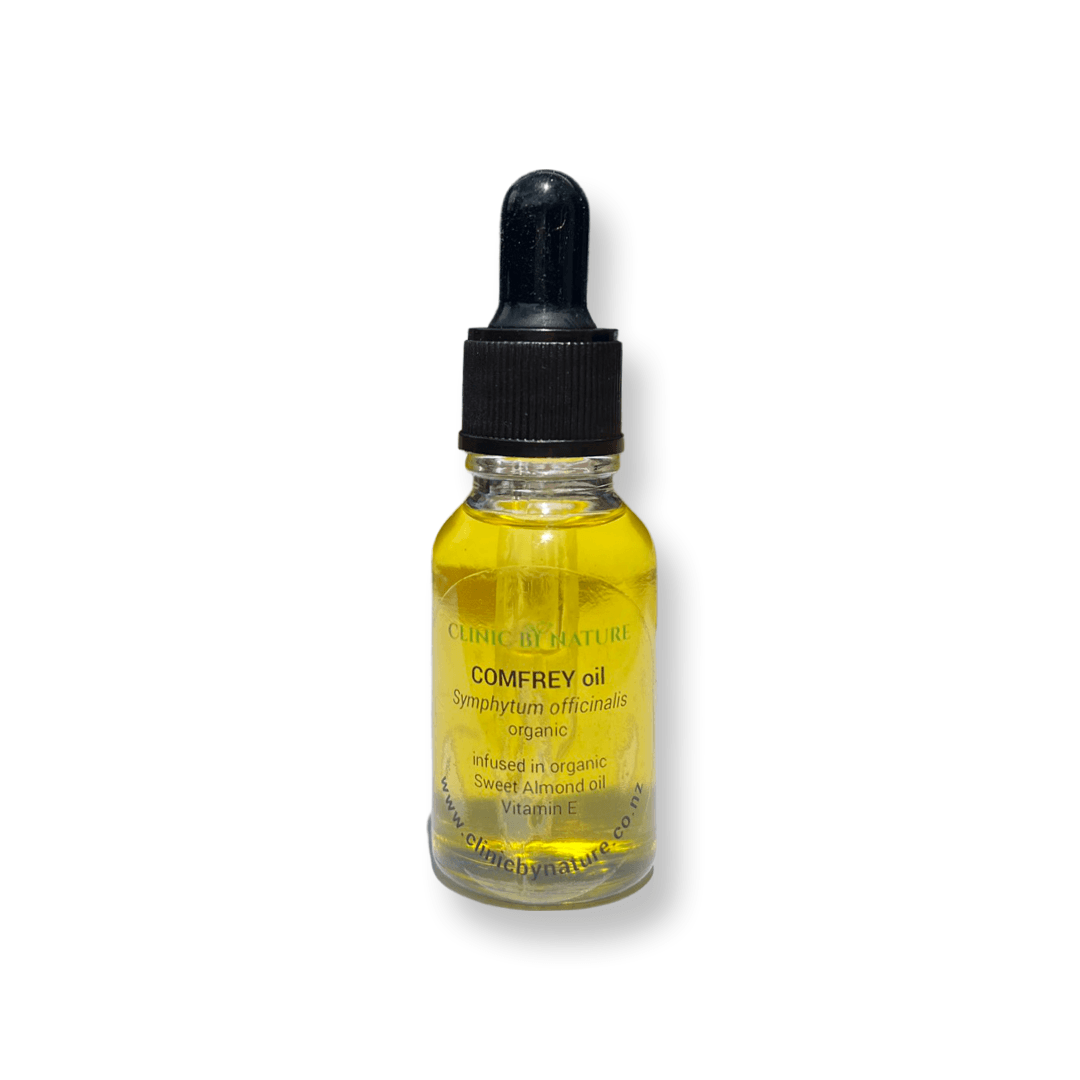Comfrey Leaf Healing Oil
$10.00 – $80.00
Comfrey Leaf Healing Oil handmade by our naturopath using ancient method of cold slow maceration in organic carrier Sweet Almond oil.
Comfrey Leaf Healing Oil (Symphytum officinalis) handmade by our naturopath using ancient method of cold slow maceration in organic carrier Sweet Almond oil.
Comfrey leaves (Symphytum officinale) have been used in traditional medicine for their potential health benefits for centuries.
Here are some potential health benefits of comfrey leaves when used externally:
- Wound Healing: Comfrey leaves have traditionally been used topically to promote wound healing. The leaves contain allantoin, a compound that is believed to aid in cell proliferation and tissue regeneration. Topical application of comfrey leaf preparations, such as our Comfrey Leaf Healing Oil, may help support the healing process of cuts, scrapes, and minor burns.
- Skin Conditions: Comfrey leaf healing oil have been used to address certain skin conditions, such as rashes, bruises, and insect bites. Their anti-inflammatory properties may help reduce swelling and soothe irritated skin.
- Joint and Muscle Support: Topical application of comfrey leaves preparation such as our Healing Oil may offer relief for certain joint and muscle issues. The anti-inflammatory properties of comfrey leaves can help reduce pain, swelling, and discomfort associated with conditions like osteoarthritis, sprains, or strains.
- Bruise Relief: Comfrey leaves are known for their potential to reduce the appearance of bruises. The application of a comfrey leaf Healing Oil to the affected area may help speed up the healing process and diminish the discolouration caused by bruising.
Comfrey plant (Symphytum officinalis) has been cultivated as a healing herb since at least 400 BCE. Comfrey plant's anti-inflammatory properties were well known by the Greeks and Romans which commonly used this medicinal herb to stop heavy bleeding, heal wounds and broken bones. It is believed that its name originated from the Latin confera
which means to knit together, and the Old English knitbone.
Comfrey has been prized since ancient times for its ability to help heal broken bones and damaged tissues.
However, it's important to note that comfrey contains pyrrolizidine alkaloids (PAs), which can be toxic to the liver. Internal use of comfrey leaves, such as consuming teas or tinctures (alcoholic extracts), is generally not recommended due to the potential risks. However, external use of comfrey leaf preparations such as our Healing Oil may offer many benefits.
How to use: rub gently into the affected or injured area. For anti-aging and rejuvenating we recommend to put a small amount (just a drop) on your face, neck, hand and other parts of the body that need rejuvenation or add a few drops to your face cream.
This oil is intended for external use only. Suitable for any skin, age, no restriction on long-term use.
Naturally formulated by our naturopath using active ingredients of: Comfrey (Symphytum officinalis) leaves, Sweet Almond oil (Prunus amygdalus dulcis), Vitamin E (D-Alpha Tocopherol) to preserve.
Modern days research -
Article "Comfrey Ointment for Back Pain":
Comfrey (Symphytum officinale and Symphytum uplandicum) is a highly popular herbal treatment amongst western medical herbalists for the topical treatment of bruises and sprains. Despite anecdotal reports of its effectiveness and anti-inflammatory and analgesic properties(1,2) however, clinical trial validation of efficacy was lacking until relatively recently. Since 2004 this situation has changed markedly, due to publication of results of three separate clinical trials involving an ointment made using comfrey root, conducted by German researchers. The first trial involved application of comfrey ointment or a placebo ointment following acute unilateral ankle distortions (sprains), in a group of 142 patients(4). Application of comfrey or placebo ointment commenced within 6 hours following the ankle sprain and continued over a period of eight days. Comfrey ointment application resulted in a more rapid reduction in swelling and pain upon movement, as well as improved joint mobility. The same researchers then undertook a second trial, also involving patients with acute ankle sprains that had occurred within the previous 6 hours, but this time using diclofenac gel as a control(5). A total of 160 patients applied either comfrey or diclofenac four times daily over a 7 day period, and were examined on days 0, 4 and 7, using a range of measurements to assess ankle swelling, pain, ease of movement, and pain upon application of pressure. While the tenderness reaction was reduced markedly by both comfrey ointment and diclofenac gel, those treated with comfrey experienced less pain upon pressure. After 7 days, an overall good or excellent efficacy was recorded by physicians for 78% of patients in the comfrey group compared to 61% in the diclofenac group, while the efficacy reported by patients themselves was 84.2% in the comfrey group, compared to 70.8% in the diclofenac group. Both physician and patient assessments of these differences reached statistical significance. Most recently, results from a third clinical trial involving comfrey ointment, this time for the treatment of acute upper or lower back pain, have been published in the British Journal of Sports Medicine (6). This latest trial was performed at the German Sport University in Cologne and three additional ambulatory centres for orthopaedics and sports medicine. A group of 120 patients with a mean age of 37 years, were treated with either an application of 4g comfrey ointment or a placebo ointment of similar appearance, three times daily for a period of 4-6 days. Patients were seen for evaluation of treatment effects on days 1 (two visits), 3 and 5, with the primary outcome measurement being the area under the curve (AUC) of the Visual Analogue Scale (VAS) on active standardised movement values. Secondary efficacy criteria were back pain at rest using assessment by patient, pressure algometry (a pain-time curve AUC over 5 days), global assessment of efficacy by the patient and investigator, analgesic medication consumption, and the level of functional impairment. During the trial patients who received comfrey ointment treatment experienced a 95.2% drop in pain intensity on active standardised movement (from 104.8 to 12.7 mm (mean VAS sum), compared to a 37.8% drop in the placebo group (100.0 to 56.5 mm).This fall in pain intensity was already apparent at the second visit which took place one hour after ointment application, as shown by a 33% drop in pain intensity in the comfrey group versus 12% in the placebo group. Using the primary variable alone, a superior effect of comfrey ointment to placebo for treatment of acute upper and low back pain independent of the pain localisation was shown, with a high level of statistical significance (p < 0.0001). Furthermore, the lesser mean AUC’s were found in all treatment centres involved in the study, although efficacy appeared to be less marked in those patients with milder rather than acute back pain. Improvement was also measured in most of the secondary variables, with both the AUC of the reported back pain at rest, the AUC of the pressure algometry in the trigger point as well as the global assessment of efficacy by the patients and the investigators showing significant superiority of the comfrey ointment group. Investigator ratings were an excellent or good assessment for 80% of patients in the comfrey treated group, versus 18.4% of patients in the placebo group. Patient global assessments were similar, being an excellent or good response in 78.4% of comfrey treated patients, versus only 18.4% in those who received placebo ointment. No difference in the frequency of adverse effects was reported between the comfrey and placebo groups. The authors concluded that comfrey ointment shows a remarkably potent and clinically relevant effect in reducing acute back pain, and that this reduction in pain was rapid and correlated to a parallel reduction in impaired movement.
References:
1. Kucera M et al. Adv Ther 17(4):204-10, 2000.
2. Koll R, Klingenburg S. Fortsch Med Orig 120(1):1-9, 2002.
3. Rasmussen PL, Phytonews 24, Phytomed Medicinal Herbs Ltd, New Zealand, ISSN 1175-0251, Feb 2006.
4. Koll R et al. Phytomedicine,11(6):470, Sept 2004
5. Predel H.G. et al, Phytomedicine 12(10):707-715, Nov 2005.
6. Giannetti BM et al, Br J Sports Med May 21, 2009 (epub ahead of print)
How to use: rub gently into the affected or injured area. For anti-aging and rejuvenating we recommend to put a small amount (just a drop two) on your face, neck, hand and other parts of the body that need rejuvenation or add a drop or two to your face cream.
This oil is intended for external use only. Suitable for any skin, age, no restriction on long-term use.
Free from Parabens, Sulphates, Propylene Glycol, Silicone, Mineral Oil, DEA's, Artificial Colours & Fragrances and not Tested on Animals. Does not contain UV filters. In the production process, only glass was used, no plastic.
Formulated and handmade by our naturopath using ancient traditional method of slow low temperature maceration avoiding direct sun exposure to extract its lipid soluble components. The healing oil kept all medicinal properties of Comfrey leaves. All ingredients are organic.
Naturally formulated and handmade by our naturopath using active ingredients of: organically grown in New Zealand Comfrey (Symphytum officinalis) leaves, organic certified Sweet Almond oil (Prunus amygdalus dulcis), Vitamin E (D-Alpha Tocopherol) to preserve.
To preserve this oil we added a generous amount of tocopherol (Vitamin E) which is called "the beauty Vitamin" for reasons as it acts as a natural antioxidant and supports anti-aging and improves skin quality. In anti-ageing medicine Comfrey oil is highly recommended for boosting softness and shine when used in a hair rinse products as well as for moisturising skin, which is why it's incorporated into many modern skin serums and creams.
You might be interested to try our other products with anti-inflammatory properties such as Relaxing Tea or Immune and Lymphatic Tea with Astragalus
and Chamomile facial toner and makeup remover
General Disclaimer:
The information on our website is presented for educational purposes only. Any product mentioned or described on this website is not intended to diagnose, cure, or prevent any disease or as a substitute for the advice of a qualified, registered medical professional. We recommend that you book an appointment with our naturopath for advice for proper application to your specific situation.
Only logged in customers who have purchased this product may leave a review.







Reviews
There are no reviews yet.